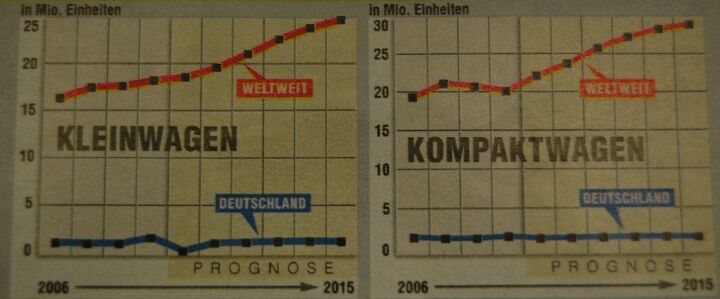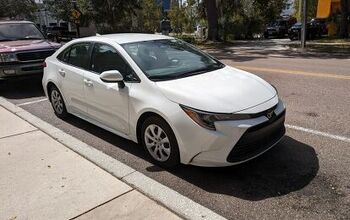German Brands Move Towards Small FWD Cars… But Not For Germans
Mercedes, BMW and Volkswagen/Audi are all moving inexorably towards a major downmarket expansion, as they develop a new generation of compact and subcompact cars based on front-wheel-drive architectures. Though Volkswagen has played in this space for some time, the move is a major cultural shift for BMW and Mercedes, which are typically associated with rear-drive luxury cars, particularly in the US market. But the truth is that the German luxury brands have always sold products in the German and other European markets that don’t match their premium overseas brand images (see, among other examples, the ubiquity of Mercedes taxis in Germany). But the strange thing about this next push towards smaller cheaper cars is that it’s not not aimed at Germany at all.
As the graph above [via Auto Motor und Sport’s August print issue] shows, German demand for compact (Kompaktwagen) and Subcompact cars (Kleinwagen) is not expected to grow by any significant amount by 2015. And to some extent, this helps justify the concept of premium small cars, as they would theoretically extract higher transaction prices out of otherwise flat demand. But that’s not reason enough to expand into small FWD segments alone, and as the graphs show, overseas sales are expected to carry the burden of small car sales growth globally. Though much of this global growth will come from low-cost car sales in China and India, the German brands can’t simply cede all the momentum to non-premium brands. Especially since small premium cars are slowly starting to be taken seriously in mature markets like the US, thanks in part to pioneers like BMW’s MINI brand.
But how low can you go? BMW kept the more-functional hatchback variants of its 1-Series out of the US in favor of a coupe-only approach, in hopes of maintaining its premium prestige there. Will its MINI-based “City” (aka “Zero-Series”) sell in decent volume in the US without hurting the RWD-only BMW brand? The new Mercedes A-Class (not to mention a possible smaller sibling) will face the same challenge, as it’s said to be based on a front-drive chassis co-developed with Nissan-Renault (potentially making it related to future US-market Nissans). Ditto Audi, which is ahead of the game with its just-released A1, and will head even further downmarket with its rebadge of the forthcoming VW up!. Again, the German market is used to these brands offering a range of products, from the pedestrian diesel taxis to super-expensive ‘bahn-burners, but outside of Germany, where growth in these small cars is expected to take place, that precedent doesn’t exist.
Of course, the real motivation for these companies is as much based on tightening emissions standards as it is on small car demand growth, so the market should be shifting to better accommodate premium front-drive compact and subcompact cars. Still, managing the transition from the current big, powerful, premium perception of German luxury brands to one that can include small, mass-market style front-drivers will be a huge challenge. And as yet, we’re not seeing a concerted effort to start getting American and other non-German consumers used to the brand image that Germans have grown comfortable with over the years.
More by Edward Niedermeyer
Latest Car Reviews
Read moreLatest Product Reviews
Read moreRecent Comments
- Michael Gallagher I agree to a certain extent but I go back to the car SUV transition. People began to buy SUVs because they were supposedly safer because of their larger size when pitted against a regular car. As more SUVs crowded the road that safety advantage began to dwindle as it became more likely to hit an equally sized SUV. Now there is no safety advantage at all.
- Probert The new EV9 is even bigger - a true monument of a personal transportation device. Not my thing, but credit where credit is due - impressive. The interior is bigger than my house and much nicer with 2 rows of lounge seats and 3rd for the plebes. 0-60 in 4.5 seconds, around 300miles of range, and an e-mpg of 80 (90 for the 2wd). What a world.
- Ajla "Like showroom" is a lame description but he seems negotiable on the price and at least from what the two pictures show I've dealt with worse. But, I'm not interested in something with the Devil's configuration.
- Tassos Jong-iL I really like the C-Class, it reminds me of some trips to Russia to visit Dear Friend VladdyPoo.
- ToolGuy New Hampshire


































Comments
Join the conversation
As with the Mini and the 1-series, the BMW Zero should be successful. Sell it more on style and dynamics than actual utility and BMW's core market will gobble it up. The B-Class isn't a very nice Benz, though it is an especially spacious MPV. Bland, boring, buzzy... I think Audi has gotten it most right with their A3 and A1. The A2 was well and truly ahead of its time... so ahead of its time that it was too expensive for the market thanks to all the aluminum. Now that the premium subcompact market is maturing, it may be the right time to reintroduce the idea.
So far A1 seems to be hitting the mark: in spite of the higher prices (compared to, say, the sister VW brand), Audi is increasing production above original plans. http://www.autonews.com/apps/pbcs.dll/article?AID=/20100825/ANE/100829924/1131